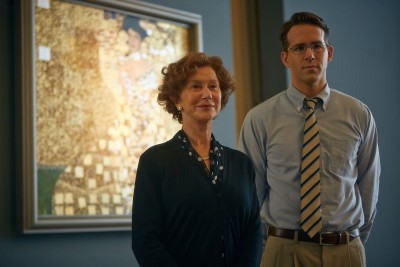
Helen Mirren and Ryan Reynolds star in “Woman in Gold,” premiering Wednesday. PHOTO COURTESY OF THE WEINSTEIN COMPANY
“Woman in Gold” may center on events that unfolded with the rise of the Third Reich, but director Simon Curtis wants viewers to know that despite the familiar premise, this film is unlike any other World War II film they might have seen previously.
In “Woman in Gold,” Helen Mirren plays Maria Altmann, a Jewish woman forced to flee Austria with her husband to the United States during the Nazi invasion. Not only does Maria lose her home, but her family also loses a prized possession — a painting of her beautiful aunt Adele Bloch-Bauer (Antje Traue) by Gustav Klimt. With the end of the war, the titular painting finds its way into government custody. Around 40 years later in Los Angeles, Maria recruits a young lawyer, E. Randol “Randy” Schoenberg (Ryan Reynolds) to help her fight the Austrian government for ownership of the painting.
The film takes place in three different time periods: Maria’s childhood, her early 20s (played by Tatiana Maslany) and the present. Incorporating events leading up to Maria’s escape from Austria was vital to Curtis, as it placed emphasis on the events surrounding the creation of the Klimt painting.
“We wanted to flash back to the past, to reinforce that this wasn’t any old painting,” Curtis said in a roundtable interview with The Daily Free Press. “This was a painting that Maria’s uncle commissioned Gustav Klimt to paint of her aunt. It was a painting that was on the wall at the family home. That family was the epitome of the entire community that was shattered when the Nazis arrived.”
A defining quality of the film is its multinational storylines. Not only are a variety of time periods explored in “Woman in Gold,” but it was also filmed in different countries, complicating the production process for Curtis and his team.
“We were filming in three cities, two languages [and] three time periods,” he said. “We had German actors speaking English and English actors speaking German. We had English-speaking actors with Austrian accents … It was a nightmare.”
While it may have been difficult to coordinate, Curtis found it imperative for the dialogue in Maria’s past to be in German, as it would help contribute to a more accurate depiction of her life.
“But more than that, it was about a woman who was born in Vienna talking German, who lived in America talking English,” he said. “The film is really a love letter to the American immigration policy, that these people were able to recreate and live lives in the United States.”
The film shows America in a positive light, he said, but it often seems like Austria comes across as the villain. Throughout her journey to reclaim the painting, Maria faces opposition from the Austrian government. In her past, too, Maria fights against the Austrian government and flees. Despite this negative depiction of Austria, Curtis said the country welcomed him to film there and applauded his creation.
“When we opened in Berlin, some of our best reviews were German and Austrian,” he said. “Someone showed me the Austrian paper where it said that this should be shown in all the schools … someone in Austria said to me that they were really proud that the painting was in New York, showing Austrian talent to the world.”
Throughout the filmmaking process, Curtis’s main goal was always to engage viewers and spread more awareness of the results of the Nazi invasion, making use of all manners of storytelling.
“It plays like a comedy, at times. And it certainly plays like a thriller at other times. And even a courtroom drama at other times. But finally, I hope people will be provoked by it and that they think about how close they are to the terrible events of World War II,” Curtis said.
One of the best things about creating historical films, Curtis said, is the ability to spread awareness about events that may not have been highlighted in the past. With “Woman in Gold,” he was able to illustrate the story of the seized artwork on a more personal level than, say “The Monuments Men.” Unexplored topics, Curtis said, provide filmmakers with countless stories to share with audiences.
“Who cared about the art when all of those millions of people lost their lives?” Curtis said. “They [the paintings] are the last hostages of World War II. I think people feel that they’re not quite ready to close the book. There are still some stories worth telling.”




